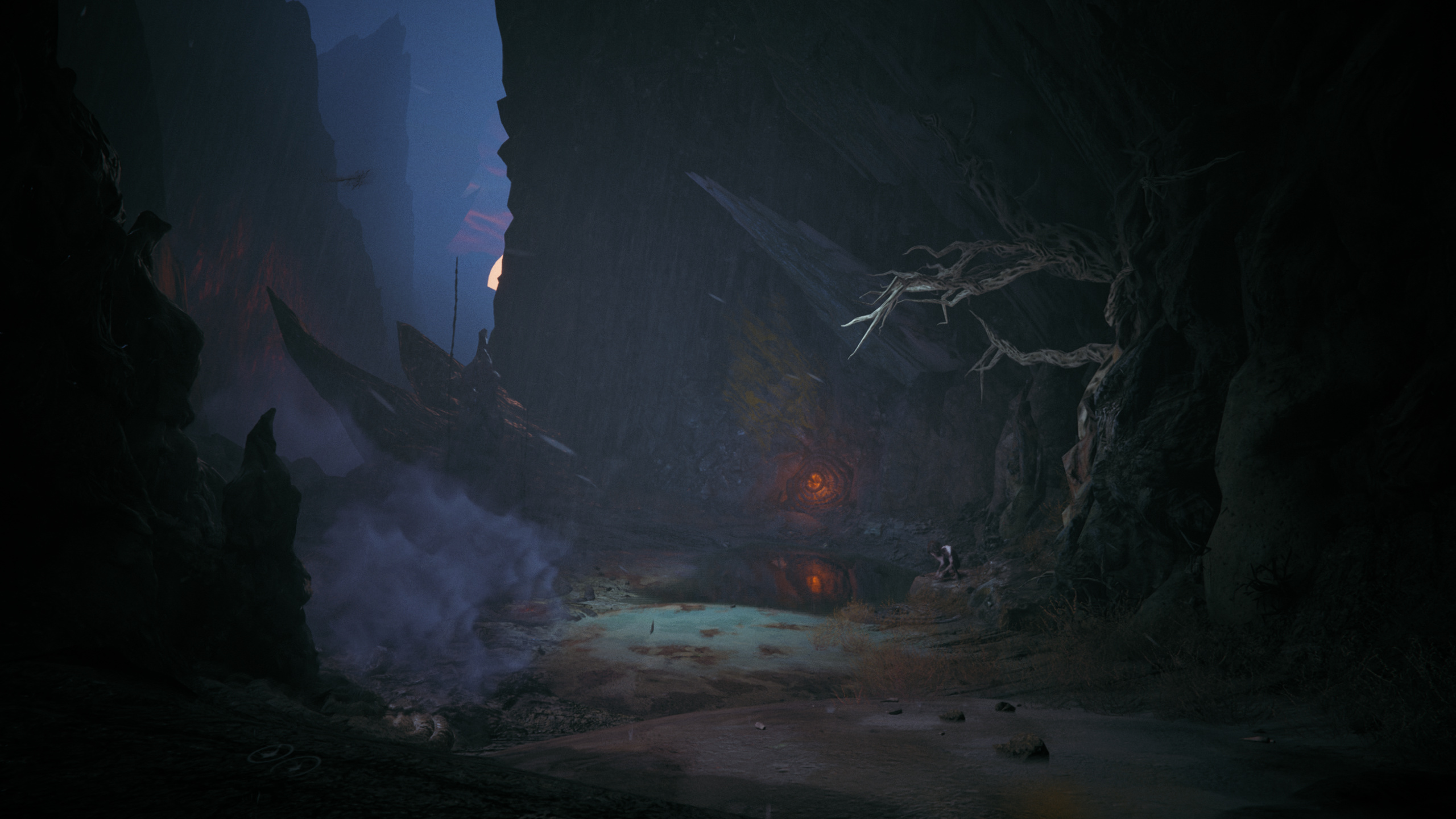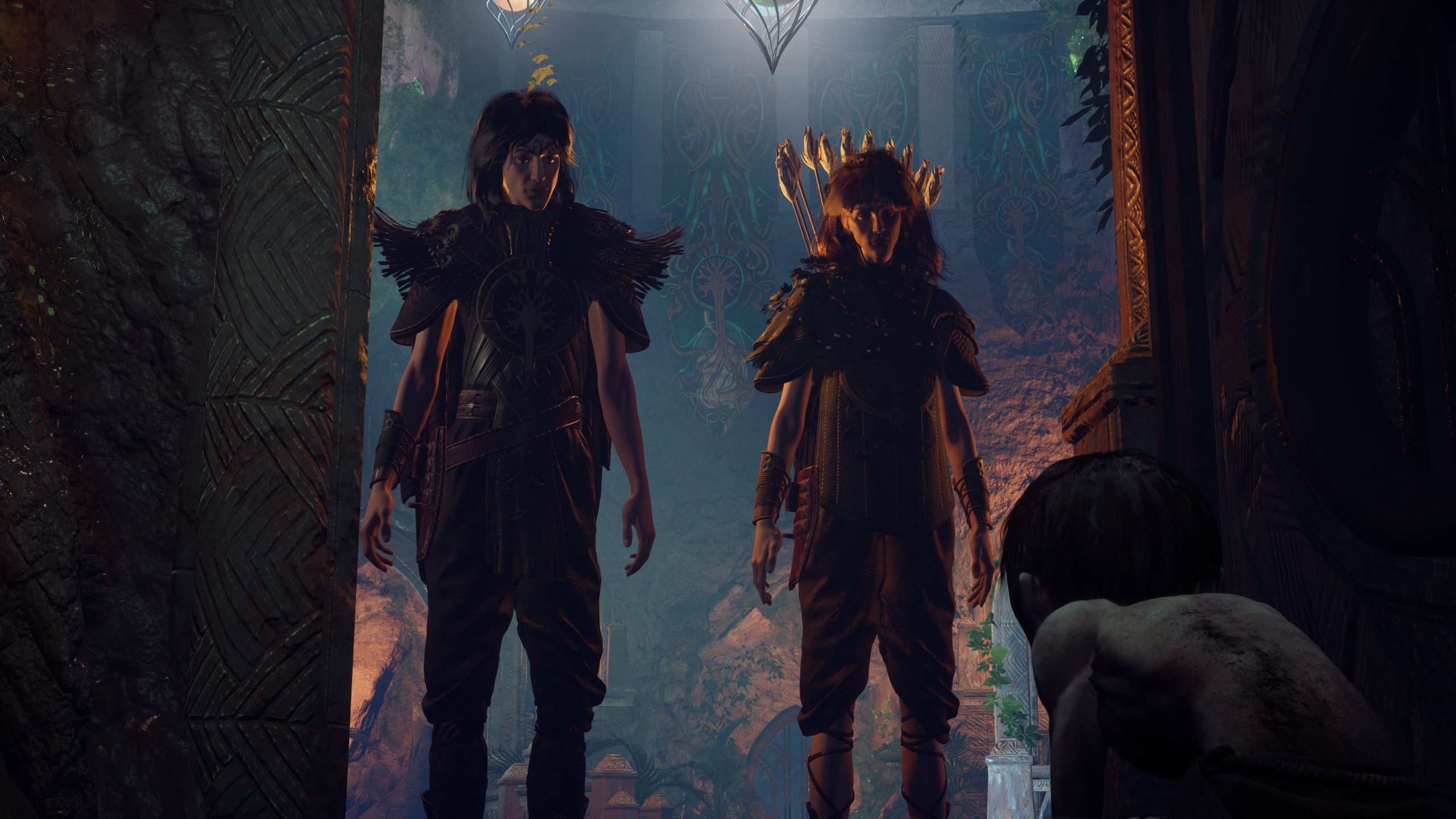Our Verdict
For all its many flaws, LOTR: Gollum is an oft-beautiful and oddly endearing adventure.
PC Gamer's got your back
What is it? A stealthy platform narrative Lord Of The Rings adventure.
Release date May 25, 2023
Expect to pay $50 / £43
Developer Daedalic Entertainment
Publisher In-house, Nacon
Reviewed on Nvidia 2080 Ti, Intel i9-9900k @ 4.9ghz, 32gb RAM
Multiplayer No
Steam Deck N/A
Link Official site
Despite my nature (a sun-averse hermit hoarding shiny treasures) giving me a certain affinity for Gollum, I’ve been a bit skeptical about Daedalic’s much-delayed Lord Of The Rings game, as early footage left me uninspired and unsure whether there was even a coherent game here. The good news is that Gollum (the game) does have some interesting ideas. Unfortunately, like its fragmented protagonist, its ideas fall into two distinct camps, and one is significantly nicer than the other.
Gollum straddles two action genres, and neither holds up to scrutiny. At heart, it’s a cinematic but basic stealth platformer. Think halfway between Uncharted’s wall-clambering navigation and Splinter Cell creeping. Not being the finest of physical specimens, Gollum is a little awkward at both, in-character and out.
On the platforming front, there’s usually a single route through each area, involving some mixture of highlighted grabbable ledges, brightly colored rope or vines to scramble across walls and the occasional bar to swing across. The environments are often gorgeous and very vertical, providing a fun excuse to make death-defying leaps. Still, Gollum is fragile and longer drops kill him instantly, ragdolling spectacularly for half a second before abruptly snapping back to the last checkpoint.
Despite frequent deaths, the path is usually clear and checkpoints generous. When intuition fails, there’s a button to engage Gollum Vision™ (Sméagoggles, perhaps) and see usable objects, enemies and hinted paths highlighted. Helpful, but unreliable, only providing useful hints sometimes. More info comes in the use of Gollum arguing with himself, calling out paths and guidance unprompted. I feel it’s a thematically excellent excuse for a much-criticized feature.
The other action element is stealth, interwoven with the jumping. Even more linear than the platforming, It’s an instant game over if Gollum gets grabbed by a guard, and there’s little margin for error. Fortunately, the sneaky bits are quite easy to navigate, with deep shadows and long grass easy to spot and the patrol routes of guards obvious. There’s also no combat. Orcs without helmets can be strangled if caught alone, but this is so infrequent that you get an achievement—“Murderer”—for offing just ten.
Sméagol's saga

While I encountered a great many little glitches when playing Gollum (this is an undeniably janky game), most were related to dropped inputs and Gollum refusing to grab onto ledges, leading to sudden deaths. I was apparently very lucky, with other players reporting significantly nastier issues, including frequent crashes and progression-breaking bugs forcing rolling back to earlier saves or worse. Your mileage may vary. If you’re not blessed with Frodo’s luck, you might be better off waiting for a few rounds of patches.
Both halves of the action side are functional but a bit undercooked. Gollum is far too filthy and emaciated to be a convincing Nathan Drake or Sam Fisher, and whether he successfully reaches for a ledge or plummets to his instant death sometimes feels random. Control inputs are sometimes dropped, and while the stealth and platforming segments alike are generously checkpointed, you either follow the intended path or die. It works, but if this was all Gollum offers, I’d have probably given up.
Thankfully, the narrative half carried Gollum for me. Whenever it’s not being a sneaky platformer, Gollum impressed me as a work of interactive Tolkien fanfic, not unlike 2021’s Guardians Of The Galaxy in its walk-and-talk formula punctuated by action. As with Guardians, it’s set against some gorgeous backdrops, and while characters are often animated stiffly (especially in dialogue), the script held my attention well. It dissects Gollum and why he remains an outsider despite any best efforts from himself or potential friends.
While it seldom changes much, there’s frequent Telltale-esque prompts where you can pick whether Gollum or Sméagol answers in dialogue. I especially liked the tense scenes requiring me to pick a side and argue in their favor, reasoning the other half into submission. Thematically, the game is also bifurcated. Set after Bilbo steals Gollum’s ring, a little over the first half of the game tells the tale of Gollum’s survival in the slave pits beneath Mordor (he’s literally neurodivergent and a miner), and his long, improvised and often-flawed plan to escape.
Pit stop

As well as mining, Gollum works in the Orc breeding pits, showing us how Sauron’s armies are farmed like belligerent sea-monkeys.
Mordor here is surprisingly grim, crueller than the cartoonish heavy metal aesthetics of Middle-Earth: Shadow Of War with its wacky orcs and sexy Shelob. This vision of Mordor is gruesomely detailed, full of ornately etched black steel, stretched and bloody hides and a lot of slick, fresh-flowing blood and black water. While there’s not a huge amount of violence shown, there’s enough unsettling aftermath to give the imagination plenty to hang onto.
The game uses this opportunity to explore the mechanics and politics of Mordor. As well as mining, Gollum works in the Orc breeding pits, showing us how Sauron’s armies are farmed like belligerent sea-monkeys. Gollum gets to feed piranha-like larval Orcs a slurry of magically fortified gore until they grow into the pallid humanoids we know and love to stab. Also getting some love are the rival factions of humans in Sauron’s employ, with The Candle Man—a scheming sorcerer that uses Gollum as an informant and toady—stealing the show.
The Orcs are visually distinct from other LOTR games. Less bulky, with vaguely insectoid, rounded metal armor with a patchwork of leather and chain holding it all together. Outside of Gollum’s design and character performance, the game isn’t particularly beholden to Peter Jackson’s movies. This is all the clearer in the latter half of the 10-12 hour campaign, which takes place in elven lands. Brighter and less murdery, but still tense, with a sense that either Gollum or the elves could snap at any moment. The Elves here are scruffy, lanky and condescending instead of willowy and ephemeral. An interestingly flawed portrayal, especially the sullen and sassy Elven teenagers Gollum is placed under the watch of.

Despite the foregone conclusion of the story (Gollum lives to cause Frodo endless grief), I invested in its personal stakes.
These two story halves didn’t quite mesh in the middle as cleanly as I’d have liked, but both held my attention. Despite the foregone conclusion of the story (Gollum lives to cause Frodo endless grief), I invested in its personal stakes. Gollum is broken, equally wanting to help or backstab depending on which personality is in the driving seat. He struggles to make friends or trust, and his strange behavior leads characters to question him and deepen those gaps.
While wonky as a platformer or a stealth game, I’m happy to find such a strong story told here, distinct from Jackson and Bakshi’s visions of Middle-Earth. Much like its boggle-eyed protagonist, one half is pragmatic but prickly and sometimes cruel, the other starry-eyed and eager to please. The gestalt is, thankfully, more than the sum of its parts.
For all its many flaws, LOTR: Gollum is an oft-beautiful and oddly endearing adventure.

The product of a wasted youth, wasted prime and getting into wasted middle age, Dominic Tarason is a freelance writer, occasional indie PR guy and professional techno-hermit seen in many strange corners of the internet and seldom in reality. Based deep in the Welsh hinterlands where no food delivery dares to go, videogames provide a gritty, realistic escape from the idyllic views and fresh country air. If you're looking for something new and potentially very weird to play, feel free to poke him on Bluesky. He's almost sociable, most of the time.


